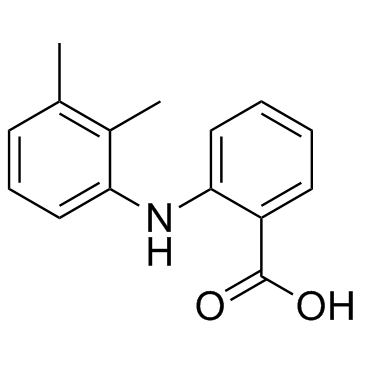Mefenamic acid

Mefenamic acid structure
|
Common Name | Mefenamic acid | ||
|---|---|---|---|---|
| CAS Number | 61-68-7 | Molecular Weight | 241.285 | |
| Density | 1.2±0.1 g/cm3 | Boiling Point | 398.8±30.0 °C at 760 mmHg | |
| Molecular Formula | C15H15NO2 | Melting Point | 230 °C | |
| MSDS | Chinese USA | Flash Point | 195.0±24.6 °C | |
| Symbol |

GHS07 |
Signal Word | Warning | |
|
Characterization of a highly sensitive and selective novel trapping reagent, stable isotope labeled glutathione ethyl ester, for the detection of reactive metabolites.
J. Pharmacol. Toxicol. Methods 76 , 83-95, (2015) Glutathione (GSH) trapping assays are widely used to predict the post-marketing risk for idiosyncratic drug reactions (IDRs) in the pharmaceutical industry. Although several GSH derivatives have been introduced as trapping reagents for reactive intermediates,... |
|
|
Cheminformatics analysis of assertions mined from literature that describe drug-induced liver injury in different species.
Chem. Res. Toxicol. 23 , 171-83, (2010) Drug-induced liver injury is one of the main causes of drug attrition. The ability to predict the liver effects of drug candidates from their chemical structures is critical to help guide experimental drug discovery projects toward safer medicines. In this st... |
|
|
Translating clinical findings into knowledge in drug safety evaluation--drug induced liver injury prediction system (DILIps).
J. Sci. Ind. Res. 65(10) , 808, (2006) Drug-induced liver injury (DILI) is a significant concern in drug development due to the poor concordance between preclinical and clinical findings of liver toxicity. We hypothesized that the DILI types (hepatotoxic side effects) seen in the clinic can be tra... |
|
|
Convenient QSAR model for predicting the complexation of structurally diverse compounds with β-cyclodextrins
Bioorg. Med. Chem. 17 , 896-904, (2009) This paper reports a QSAR study for predicting the complexation of a large and heterogeneous variety of substances (233 organic compounds) with beta-cyclodextrins (beta-CDs). Several different theoretical molecular descriptors, calculated solely from the mole... |
|
|
The Japanese toxicogenomics project: application of toxicogenomics.
Mol. Nutr. Food. Res. 54 , 218-27, (2010) Biotechnology advances have provided novel methods for the risk assessment of chemicals. The application of microarray technologies to toxicology, known as toxicogenomics, is becoming an accepted approach for identifying chemicals with potential safety proble... |
|
|
Developing structure-activity relationships for the prediction of hepatotoxicity.
Chem. Res. Toxicol. 23 , 1215-22, (2010) Drug-induced liver injury is a major issue of concern and has led to the withdrawal of a significant number of marketed drugs. An understanding of structure-activity relationships (SARs) of chemicals can make a significant contribution to the identification o... |
|
|
A predictive ligand-based Bayesian model for human drug-induced liver injury.
Drug Metab. Dispos. 38 , 2302-8, (2010) Drug-induced liver injury (DILI) is one of the most important reasons for drug development failure at both preapproval and postapproval stages. There has been increased interest in developing predictive in vivo, in vitro, and in silico models to identify comp... |
|
|
Multiresidue method for the determination of pharmacologically active substances in egg and honey using a continuous solid-phase extraction system and gas chromatography-mass spectrometry.
Food Chem. 178 , 63-9, (2015) A sensitive, selective, efficient gas chromatography-mass spectrometry method for the simultaneous determination of 22 pharmacologically active substances (antibacterials, nonsteroidal antiinflammatories, antiseptics, antiepileptics, lipid regulators, β-block... |
|
|
Microextraction of non-steroidal anti-inflammatory drugs from waste water samples by rotating-disk sorptive extraction.
Talanta 128 , 486-92, (2014) In this study, six non-steroidal anti-inflammatory drugs (NSAIDs) were extracted from water samples using the rotating-disk sorptive extraction (RDSE) technique. The extraction disk device contains a central cavity that allows for the incorporation of a powde... |
|
|
Simultaneous determination of polar pharmaceuticals and personal care products in biological organs and tissues.
J. Chromatogr. A. 1355 , 193-205, (2014) In the present study, a sensitive and accurate isotope dilution method was developed for the simultaneous determination of 17 polar pharmaceutical and personal care product (PPCP) residues (logKow=1.40-5.74), including 14 pharmaceuticals and 3 personal care p... |